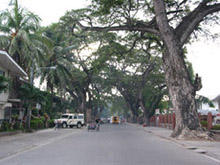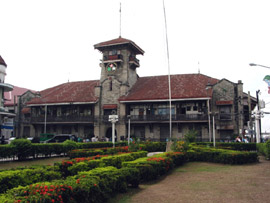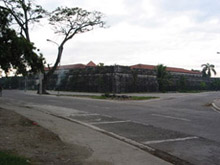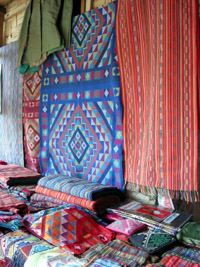
Bienvenidos a Zamboanga.com
Welcome to Zamboanga.com

This is a site developed by Zamboangueños with the aim to give people the real inside scoop about Zamboanga City. Zamboanga will surely enchant you with the richness of its heritage- talk about quaint city charm at the turn of the 20th century.Zamboanga is a city of romantic dreams. Chabacano, its "lingua franca" has long enchanted people from the other parts of the Philippines. The unique Spanish patois is a sprinkling of Spanish and local dialects of the archipelago. It will make you dream of the lovely city and its even lovelier "bellisimas" which Zamboanga City is known for.
There was a time when travellers were given fair warning- not to venture to fair Zamboanga where they will tragically forget all and who they have left behind. Hence the song, "Don't You Go To Far Zamboanga".
Zamboanga was once called "Jambangan" by the early Malays for the flowers that ran riot in an abandon of color. And until now, Zamboangueños and all those who have visited Zamboanga will be reminded of the city everytime one sees the gay Bougainvillea- which has become synonymous to the city. It still grows in wild abandon over the walls and arches of most Zamboangueñ home.
Through the Spanish, American , and post-War eras, Zamboangueño hospitality has become legendary. "Mi casa es su casa" -Make yourself at home, is not just an old saying in Zamboanga. The same hospitality of old Zamboanga is still yours whether you are a visitor in a Zamboangueño home or at any of Zamboanga's fine hotels. No wonder they called her "Preciosa Perlita, Orgullo de Mindanao"- Precious Pearl, Pride of Mindanao.
The city is a melting pot of different cultures and different ways of life. An eclectic mix of modern lifestyle and the ways of Old Zamboanga. A contrast like the city's busy modern commercial district along "Guardia Nacional" and lazy "siesta" afternoons of Pasonanca Park, which gained world renown as early as 1960's for its Scout camp and Amphitheater, treehouse and natural pools. But there are no concret jungles in the City of Flowers. Instead there are streets lined with tall palm trees proudly waving towards the sky and ancient Acacia trees offering their shade from the noonday sun as they always have for centuries.

With the great Zamboanga weather, one can enjoy the beaches of Sta.Cruz Island with its pinkish beach sand, the Zamboanga Beach Park and mingle --with the crowd, maybe see a golf tourney in the neighboring Zamboanga Golf Course & Country Club, Or enjoy the sea breeze at La Vista del Mar while enjoying the luscious seafood offerings of its restaurant. And if takes your fancy, riding a "vinta" can be a great way to laze the afternoon away. And at the end of the day, enjoy the Zamboanga sunset at the R.T. Lim Boulevard also known as Cawa-Cawa-,a favorite promenade for lovers and friends.
Food is one of the Zamboangueños' passion and is never more so revealed than in the celebrations of the different town
fiestas- celebrations that are just but reasons to indulge in the enjoyment of rich food, warm friendships and close family
ties. Seafood fare abound with the famed "Curacha" reigning supreme.Come October, and the biggest celebration of them all is welcomed with a weeklong merrymaking. The Zamboanga Hermosa Festival , a weeklong celebration that packages the Fiesta Pilar (Feast Day of The lady of The Pillar) is ushered in with pomp & pageantry -beauty pageants, concerts at the park, musical competitions that showcase Zamboanga's rich heritage-The Brass Band Competition and the Chavacano Song Festival, Food and Agri Trade Fairs and special bazaars or "Fondas" that showcase Zamboanga's best, Duelos delos Pistoleros,and the famed colorful Regatta competition in Cawa-Cawa Beach. All these culminate with the lively and colorful Street Dancing and Parade of Floats.
One can also immerse one's self in culture by visiting the different historic monuments built during the Spanish and American Occupation. It entails a visit to the museum inside the Fort Pilar. The Castilian flag was first seen at Caldera Bay (Recodo) in 1593. The coastal Spanish fort was built in 1635 and is now a premier landmark of Spanish culture and is an indelible mark of the long Spanish presence in the city. The Spaniards stayed on for three centuries. And in that time, the fort became a shrine as legend of the miraculous events of the lady of the Pillar began to be told. One popular legend has it that a sleeping soldier was awakened by a lady and warned of the invasion of a group of marauders. Thus, the Fort was ready when the attack came. It is believed that the lady was Mary. And so the Fort is named in her honor, "The Lady of the Pillar". More & more people from the neighboring islands came to seek protection from the sea marauders under the walls of Fort Pilar.
Another historic site is the Zamboanga City Hall , formerly the Provincial Capitol Building, which was built in 1905-1907 during the American occupation. A few more buildings built during the same time are still standing along the streets of Cityhall. The Plaza Pershing is a remnant of a Spanish Plaza of the 17th century. It was first called Plaza de Don Juan de Salcedo.It was later changed to Plaza Pershing , named in honor of American Military Governor John "Blackjack Pershing who was in residence at the Provincial Capitol Building, a name that lives on to this day. It has withstood the ravages of war with a few "facelifts". It is a favorite spot for people-watching. And many locals frequent the area to indulge in the favorite pastime of "chismis" (chatting) and exchanging opinions about religion, culture and life in general.

Then there's the Yakan Weaving Village in Upper Calarian. Here one can get handwoven Yakan cloth and brass novelties at best prices. This is a bargain-hunter's heaven as one can get antiques here at great value. From handwoven tablerunners, coasters, "malongs" and bags and pouches to antique weapons and brass items.
Or go bargain -hunting at the Barter Trade Center. Barter-trading has long been a part of Zamboanga since the pre-Spanish time. Zamboanga was already a trading hub for the Chinese, malays and natives. Chinese junks used to dock in the archipelago's ports as the natives exchanged gold for Chinese silk and ceramics and other what-nots. The natives also traded with the Malays. This trading tradition has evolved to what it is today. If one goes to the different barter trades of Zamboanga, nothing much has changed. One will see an abundant display of wares from its Asian neighbors like China, Taiwan, Singapore, Indonesia, and Malaysia- to name a few. Only the currency has changed.
Zamboanga City may also be one of the few cities where Christianity and Islam live and flourish in co-existence for centuries, an indication of the graceful and seamless integration of culture and history in Zamboanga City. One of the oldest witness to this co-existence is the Taluksangay Mosque which was built in 1885. During the Spanish Occupation, the Archdiocese of Zamboanga included all of Mindanao, except Sulu where the Tausug culture and Islam proved to be as dynamic as the Spanish influence. Today, the Taluksangay Mosque and a lot more built after proves the vitality of Islam in the region. The Zamboanga Metropolitan Cathedral, the biggest cathedral in Mindanao, shows the balance of religion in Zamboanga City.But we be Christian or Muslim, we are first and foremost Zamboangueños to the world. We are Zamboanga. Vamonos! Come and see for yourself.

HOMEPAGE LOCAL GOVERNMENT DIRECTORY
TOURIST SPOTS MUSEUM@THE FORT FORT PILAR LEGEND OF THE FORT PASONANCA PARK
ABONG-ABONG PARK CESAR CLIMACO BARTER TRADE CENTER YAKAN VILLAGE
STA. CRUZ ISLANDS LA VISTA DEL MAR ZC GOLF COURSE ZAMBOANGA BEACH PARK RT LIM BOULEVARD
CAWA-CAWA CARAGASAN REGATTA DIA DE ZAMBOANGA CUSINA CHAVACANO
CONVERSA CHABACANO HOTELS RESTAURANTS TRANSPORTATION NOVELTY ITEMS PHILIPPINE NATIVE PRODUCTS



